Bengali literature
Bengali literature (Bengali: বাংলা সাহিত্য, romanized: Bangla Shahitto) denotes the body of writings in the Bengali language. Bengali has developed over the course of roughly 1,300 years. The earliest extant work in Bengali literature is the Charyapada, a collection of Buddhist mystic songs dating back to the 10th and 11th centuries, and considered to be written in an ancestor language of Bengali, Assamese, Odia and many other languages belonging to the Eastern branch of the Indo-Aryan languages. The timeline of Bengali literature is divided into three periods − ancient (650-1200), medieval (1200-1800) and modern (after 1800). Medieval Bengali literature consists of various poetic genres, including Hindu religious scriptures (e.g. Mangalkavya), Islamic epics (e.g. works of Syed Sultan and Abdul Hakim), Vaishnava texts (e.g. biographies of Chaitanya Mahaprabhu), translations of Arabic, Persian and Sanskrit texts, and secular texts by Muslim poets (e.g. works of Alaol). Novels were introduced in the mid-19th century. Other than the Eastern Nagari script, Bengali has been written with different scripts such as the Perso-Arabic and Sylheti Nagri in certain parts of history.[1] Nobel Laureate Rabindranath Tagore was the best known figure of Bengali literature to the world. Kazi Nazrul Islam, notable for his activism and anti-British literature, was described as the Rebel Poet and is now recognised as the National poet of Bangladesh.
| Bengali literature বাংলা সাহিত্য | |
|---|---|
 | |
| Bengali literature | |
| By category Bengali language | |
| Bengali language authors | |
| Chronological list – Alphabetic List | |
| Bengali writers | |
| Writers – Novelists – Poets | |
| Forms | |
| Novel – Poetry – Science Fiction | |
| Institutions and awards | |
| Literary Institutions Literary Prizes | |
| Related Portals Literature Portal India Portal | |
| Part of a series on |
| Bengalis |
|---|
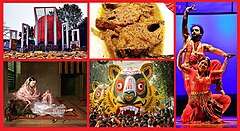 |
|
Bengali homeland |
|
Bengali culture
|
|
Bengali symbols |
Ancient (c. 650-1200)
The first works in Bengali, appeared between 10th and 12th centuries C.E.[2] It is generally known as the Charyapada and are 47 mystic hymns composed by various Buddhist monks, namely; Luipada, Kanhapada, Kukkuripada, Chatilpada, Bhusukupada, Kamlipada, Dhendhanpada, Shantipada and Shabarapada amongst others. The manuscript was discovered on a palm leaf in the Nepal Royal Court Library in 1907 by the Bengali linguist Haraprasad Shastri. Due to the language of these manuscripts only being partially understood, they were classified by Shastri with the name Sandhya Bhasha (সন্ধ্যা ভাষা), meaning dusk language.
Medieval (1200-1800)
Early medieval/Transitional (1200-1350)
This period is considered to be the time in which many common proverbs and rhymes first emerged. The Bengali alphabet became a lot like what it currently is. Ramai Pandit and Halayudh Misra were notable writers of this period.[3]
Pre-Chaitanya (1350-1500)

Muslim writers were exploring different themes through narratives and epics such as religion, culture, cosmology, love and history; often taking inspiration from or translating Arabic and Persian literary works such as the Thousand and One Nights and the Shahnameh.[4] The literary romantic tradition saw poems by Shah Muhammad Sagir on Yusuf and Zulaikha, as well as works of Sabirid Khan. The Dobhashi culture introduced Arabic and Persian vocabulary into Bengali texts to illustrate Muslim stories. Epic poetry included Nabibangsha by Syed Sultan, Janganama by Abdul Hakim and Rasul Bijoy by Shah Barid.[5]
Chandidas was the celebrated Hindu lyrical poet of this period, famed for translating Jayadeva's work from Sanskrit to Bengali and for producing thousands of poems dedicated to the love between Radha and Krishna such as the Shreekrishna Kirtana. Majority of Hindu writers in this period drew inspiration from a popular Maithili language Vaishnavite poet known as Vidyapati. Maladhar Basu's Sri Krishna Vijaya, which is chiefly a translation of the 10th and 11th cantos of the Bhagavata Purana, is the earliest Bengali narrative poem that can be assigned to a definite date.[6] Composed between 1473 and 1480 C.E., it is also the oldest Bengali narrative poem of the Krishna legend.[7][6] The Ramayana, under the title of Sri Rama Panchali, was translated by Krittibas Ojha.[8][8]
Chaitanya era (1500-1700)

Bengali literature flourished in Arakan following its reconquest. It was home to prominent writers patronised in the Arakan royal court such as Alaol, who wrote Padmavati, as well as Daulat Qazi, Dawlat Wazir Bahram Khan, Quraishi Magan Thakur who wrote Chandravati and Maradan who wrote Nasirnama. Qazi was the first poet under the court patronage. He started writing Satimayna O Lorchandrani, considered to be the first Bengali romance. Teamwork was common in the court, and Alaol finished off Qazi's romance as the latter had died before managing to complete it.[14]
Modern (1800-present)
Michael Madhusudan Datta's first epic Tilottama Sambhab Kabya published in 1860 was the first Bengali poem written in blank verse. Bankim Chandra Chatterjee was considered one of the leading Bengali novelists and essayists of the 19th century. He also wrote Vande Mataram, the national song of India, which appears in his novel Anandamath (1882).[15] In the 1880s, Chatterjee critically analysed Hindu scriptures such as the Bhagavad Gita as well as the problems of Krishnaism from a historical perspective in his Dharmatattva and Krishna Charitra.[15]
Romesh Chunder Dutt and Mir Mosharraf Hossain are notable for their works of fiction. Girish Chandra Ghosh and Dwijendralal Ray were prominent playwrights of the time, whereas Akshay Kumar Boral and Ramendra Sundar Tribedi are famous for their influential essays. Rassundari Devi authored the first full-fledged autobiography in modern Bengali literature in 1876.[16]
The Pre-Tagore era also saw an undercurrent of popular literature which was focused on daily life in contemporary Bengal. The prose style, as well as the humour in these works, were often crass, blunt and accessible. A masterpiece in this regard was "Hutom Pechar Naksha" (The Sketch of the Owl) written by Kaliprasanna Singha, and satirically depicts "Babu" culture in 19th century Kolkata. Other notable works in this regard are "Alaler Ghorer Dulal" (The Spoilt Brat) by Peary Chand Mitra, "Ramtanu Lahiri o tatkalin Banga shamaj" (Ramtanu Lahiri & contemporary Bengali society) by Nyaymohan Tarkalankar, and "Naba Babu Bilas" & "Naba Bibi Bilas" by Bhabanicharan Bandopadhyay. These books arguably portrayed contemporary Bengali dialect and popular society effectively, and also incorporated now-extinct music genres such as Khisti, Kheur and Kabiyal gaan by stalwarts like Rupchand Pakhi and Bhola Moyra. Books like these have become rarer since the emergence of Tagore culture, and the burgeoning preference for literary elegance and refinement in Bengali society.[17]
 Bankim Chandra Chatterjee's first novel Durgeshnandini was considered a benchmark in the history of Bengali literature.[15]
Bankim Chandra Chatterjee's first novel Durgeshnandini was considered a benchmark in the history of Bengali literature.[15]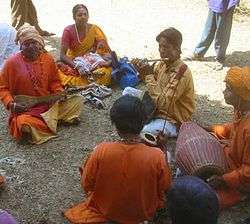 Baul singers at Vasantotsav, Shantiniketan.
Baul singers at Vasantotsav, Shantiniketan.- Shaheed Minar, Dhaka as displayed on the annual anniversary of Bengali Language Movement.
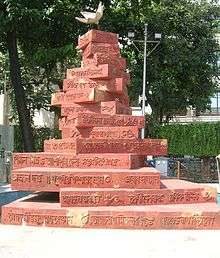
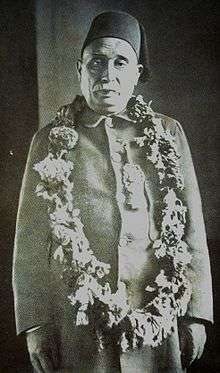 Kaykobad was a popular narrative poet.
Kaykobad was a popular narrative poet.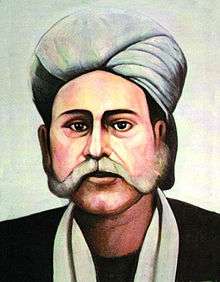 Hason Raja's poetry continues to be prominent in rural Bengal.
Hason Raja's poetry continues to be prominent in rural Bengal.
Nazrul and Tagore

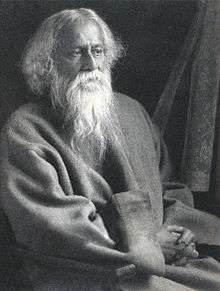
Rabindranath Tagore and Kazi Nazrul Islam are the most well-known prolific writers of Bengal in this century. Tagore is celebrated as the writer of both India's national anthem, Jana Gana Mana and Bangladesh's Amar Shonar Bangla as well as being a source of inspiration for the Sri Lanka Matha and similarly Nazrul is celebrated as the national poet of Bangladesh.[18][19][20]
Short story writers
Bengali literature is also famous for short stories. Some famous short story writers are Rabindranath Tagore, Manik Bandopadhyay, Jagadish Gupta, Tarashankar Bandopadhyay, Bibhutibhushan Bandopadhyay, Rajshekhar Basu (Parasuram), Syed Mujtaba Ali, Premendra Mitra,[21]
1947-1965
Rajshekhar Basu (1880–1960) was the best-known writer of satiric short story in Bengali literature.[22] He mocked the charlatanism and vileness of various classes of the Bengali society in his stories written under the pseudonym "Parashuram".[22] His major works include: Gaddalika (1924), Kajjwali (1927), Hanumaner Swapna (1937), Gamanush Jatir Katha (1945), Dhusturimaya Ityadi Galpa (1952), Krishnakali Ittadi Galpa (1953), Niltara Ittadi Galpa (1956), Anandibai Ittadi Galpa (1958) and Chamatkumari Ittadi Galpa (1959). He received the Rabindra Puraskar, the highest literary award of Paschimbanga in 1955 for Krishnakali Ityadi Galpa.[23] Rajsheskhar was also a noted lexicographer, translator and essayist. His Chalantika (1937) is one of the most popular concise Bengali dictionaries, while his Bengali-language translations of Meghaduta (1943), the Ramayana (1946), the Mahabharata (1949) and the Bhagavat Gita (1961) are also acclaimed.[22] His major essays are included in Laghuguru (1939) and Bichinta (1955).[22]
Prakalpana Movement
Prakalpana Movement, branded by Steve LeBlanc, the noted US critic, as 'a tiny literary revolution', 'nurtured' by Kolkata, has been fostering its new genres of Prakalpana fiction, Sarbangin poetry and Chetanavyasism for over four decades, spearheaded by Vattacharja Chandan, beginning in 1969. It is probably the only bilingual (Bengali -English) literary movement in India mothered by Bengali literature, that has spread its wings worldwide through the participation of well known international avant-garde writers and mail artists such as Richard Kostelanetz, John M. Bennett, Sheila Murphy, Don Webb, with notable Bengali poets, writers and artists like Vattacharja Chandan.[24]
See also
References
- Mohammad Daniul Huq & Pabitra Sarkar (2012). "Bangla Language". In Islam, Sirajul; Miah, Sajahan; Khanam, Mahfuza; Ahmed, Sabbir (eds.). Banglapedia: the National Encyclopedia of Bangladesh (Online ed.). Dhaka, Bangladesh: Banglapedia Trust, Asiatic Society of Bangladesh. ISBN 984-32-0576-6. OCLC 52727562. Retrieved 15 August 2020.
- Sen, Sukumar (1979) [1960]. History of Bengali (3rd ed.). New Delhi: Sahitya Akademi. p. 24. ISBN 81-7201-107-5.
- Mohammad Daniul Haq & Aminur Rahman (2012). "Bangla Literature". In Islam, Sirajul; Miah, Sajahan; Khanam, Mahfuza; Ahmed, Sabbir (eds.). Banglapedia: the National Encyclopedia of Bangladesh (Online ed.). Dhaka, Bangladesh: Banglapedia Trust, Asiatic Society of Bangladesh. ISBN 984-32-0576-6. OCLC 52727562. Retrieved 15 August 2020.
- "The development of Bengali literature during Muslim rule" (PDF). Archived (PDF) from the original on 9 August 2017. Retrieved 22 September 2017.
- "Sufi Literature". Banglapedia. Archived from the original on 11 September 2016.
- Sen, Sukumar (1979) [1960]. History of Bengali (3rd ed.). New Delhi: Sahitya Akademi. pp. 65–66. ISBN 81-7201-107-5.
- Ahmed, Wakil (2012). "Maladhar Basu". In Islam, Sirajul; Jamal, Ahmed A. (eds.). Banglapedia: National Encyclopedia of Bangladesh (Second ed.). Asiatic Society of Bangladesh.
- Sen, Sukumar (1991, reprint 2007). Bangala Sahityer Itihas, Vol.I, (in Bengali), Kolkata: Ananda Publishers, ISBN 81-7066-966-9, pp.105-10
- Caudhurī, Ābadula Āhasāna (1992). Lālana Śāha, 1774 - 1890 (1. punarmudraṇa. ed.). Ḍhākā: Bāṃlā Ekāḍemī. ISBN 978-9840725977. OCLC 246442470.
- Urban, Hugh B. (2001). Songs of ecstasy tantric and devotional songs from colonial Bengal. New York: Oxford University Press. p. 18. ISBN 978-0-19-513901-3.
- Tagore, Rabindranath; K. Stewart, Tony (Translation); Twichell, Chase (Translation) (2003). The lover of God. Port Townsend, Wash.: Consortium Book Sales & Dist. p. 94. ISBN 978-1556591969.
- Hossain, Abu Ishahaq (2009). Lalon Shah, the great poet. Dhaka: Palal Prokashoni. p. 148. ISBN 978-9846030679.
- Ginsberg, Allen; Foley, Jack (Winter–Spring 1998). "Same Multiple Identity: An Interview with Allen Ginsberg". Discourse. 20 (1/2, The Silent Beat): 158–181. ISSN 1522-5321. JSTOR 41389881.
- Sen, Sukumar (1993). Islami Bangla Sahitya (in Bengali), Kolkata: Ananda Publishers, ISBN 81-7215-301-5, pp.23-33
- Sen, Sukumar (1979) [1960]. History of Bengali (3rd ed.). New Delhi: Sahitya Akademi. pp. 211–12. ISBN 81-7201-107-5.
- Deepa Bandopadhyay. "নারীর লেখা নারীর কথা". Archived from the original on 19 May 2015.
- "Archived copy" (PDF). Archived from the original (PDF) on 5 July 2010. Retrieved 16 March 2010.CS1 maint: archived copy as title (link)
- de Silva, K. M.; Wriggins, Howard (1988). J. R. Jayewardene of Sri Lanka: a Political Biography – Volume One: The First Fifty Years. University of Hawaii Press. p. 368. ISBN 0-8248-1183-6.
- "Man of the series: Nobel laureate Tagore". The Times of India. Times News Network. 3 April 2011.
- "How Tagore inspired Sri Lanka's national anthem". IBN Live. 8 May 2012.
- "Mosquito and Other Stories by Premendra Mitra". Purple Pencil Project. 4 March 2019. Retrieved 9 June 2020.
- Das, Sisir Kumar, ed. (2003). Samsad Bangla Sahityasangi [Samsad Companion to Bengali Literature] (in Bengali) (1st ed.). Kolkata: Sahitya Samsad. p. 189. ISBN 81-7955-007-9.
- Adhya, Hemanta Kumar (2001). Rajshekhar Basu. Bharatiya Sahityakar Pustakmala (in Bengali) (1st ed.). Kolkata: Sahitya Akademi. 41-45.
- Songs of Kobisena by Steve Leblanc in Version 90, PMS Cafe Press, Alston, MS, USA.
External links
| Wikimedia Commons has media related to Bengali literature. |
